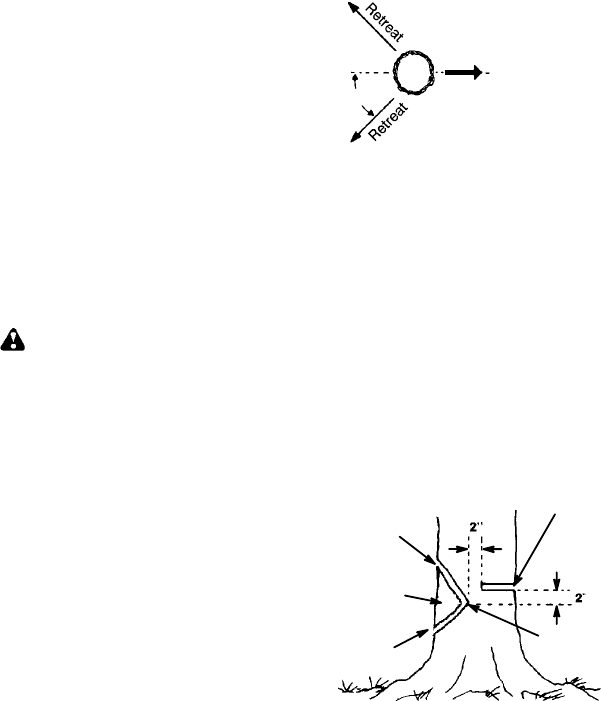
11
S Keep the chain out of dirt and sand. Even a
small amount of dirt will quickly dull a chain
and thus increase the possibility o f kickback.
S Practice cutting a few small logs using the
following techniques t o get the“feel” of us-
ing your saw before you begin a major
sawing operation.
S Squeeze the throttle trigger and allow
the engine to reach full speed before
cutting.
S Begin cutting with the saw frame
against the log.
S Keep the engine at full speed the entire
time you are cutting.
S Allowthechainto cutfor you. Exert only
light downward pressure. If you force
the cut, damageto the bar,chain, oren-
gine can result.
S Release the throttle trigger as soon as
the cut is completed, allowing the en-
gine to idle. If you run the saw at full
throttle without a cutting load,unneces-
sary wear can occur to the chain, bar,
and engine. It is recommended that
the engine not be operated for lon-
ger than 30 seconds a t full throttle.
S Toavoidlosingcontrolwhencut iscom-
plete,donot putpressure onsaw atend
of cut.
S Stop the engine before setting the saw
down after cutting.
TREE FELLING TECHNIQUES
WARNING: Check for broken or
dead branches which can fall while cutting
causing serious injury. Do notcut near build-
ings or electrical wires if you do not know the
direction oftree fall,nor cut atnight since you
will not be ale to see well, nor during bad
weather such as rain, snow, or strong winds,
etc. If the tree makes contact with a n y utility
line, the utility company should be notified
immediately .
S Carefully planyour sawing operationin ad-
vance.
S Clear thework area. Youneeda clear area
all aroundthetree so you can have secure
footing.
S The chain saw operator should keep on
the uphill side of the terrain a s the tree is
likely torollor slidedownhillafterit is felled.
S Study the natural conditions that can cause
the tree to fall in a particular direction.
Natural conditions that can cause a tree to
fall in a par ticular direction include:
S The wind direction and speed.
S The lean of the tree. The lean of a tree
might not be apparent due to uneven or
sloping terrain. Use a plum b orlevel to de-
termine the direction of tree lean.
S Weight and branches on one side.
S Surrounding trees and obstacles.
Look for decay and rot. If the trunk is rotted,
it can snap and fall toward the operator.
Check for broken or dead branches w hich
can fall on you while cutting.
Make sure there i s enough room for the tree t o
fall. Maintain a distance of
2-1/2 tree lengths
from the nearest person or other objects. En-
gine noise can drown out a warning call.
Remove dirt, stones, loose bark, nails, sta-
ples, and wire fromthe tree wherecuts are to
be made.
Plan a clear retreat pat hto the rear and diag-
onal to the line of fall.
Direction of Fall
45_
Plan a clear retreat path
FELLING LARGE TREES
(6 inches (15 cm) in diameter or lar ger)
The not ch method is used to fell large trees.
A notch is cut on theside ofthe treein thede-
sired direction of fall. After a felling cut is
made on the opposite side of tree, the tree
will tend to fall into the notch.
NOTE: If the tree has large buttress roots,
removethem before making the notch. If us-
ing saw to remove buttress roots, keep saw
chain from contacting groundto preventdull-
ing of the chain.
NOTCH CUT AND FELLING THE
TREE
S Make notch cut by cutting the top of the
notch first. Cut through
1/3 of the diameter
ofthetree. Next complete thenotch bycut-
ting the bottom of the notch. See illustra-
tion. Once the notch is cut remove the
notch of wood from the tree.
Notch
First cut
Second cut
Final (felling) cut here, 2 inches
(5 cm) above center of notch.
Hinge
S After removing the wood from the notch,
make the felling cut on the opposite side of
the notch. This is done by making a cut about
two inches (5 cm) higher than the center of
the notch. This will leave enough uncut wood
between the felling cut and the not ch to form
a h inge. This hinge will help prevent the tree
from falling in the wrong direction.


















